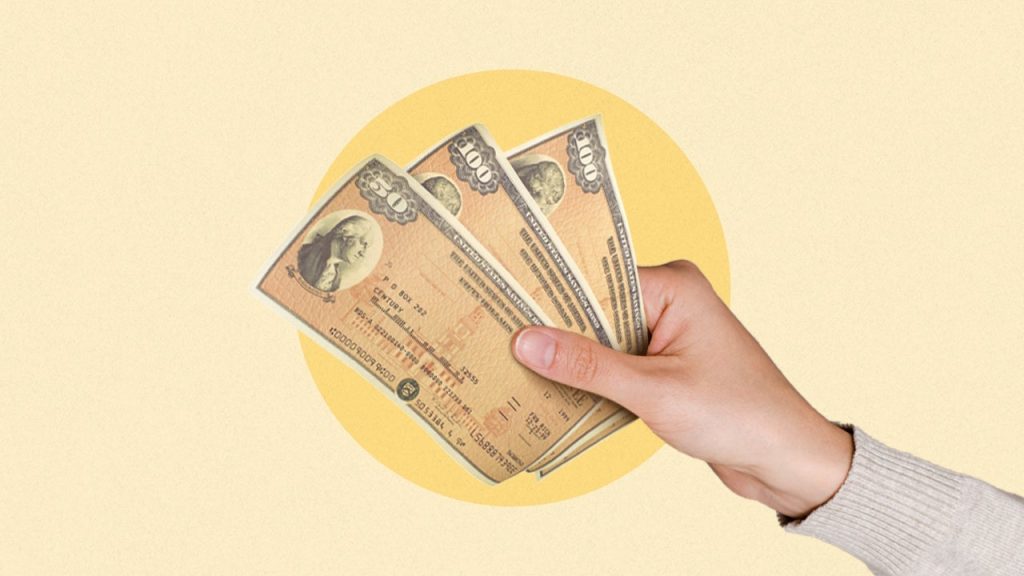Key takeaways
- A U.S. savings bond is a low-risk way to save money, which is issued by the Treasury and backed by the U.S. government.
- Savings bonds pay interest only when they’re redeemed by the owner, and they earn interest for as long as 30 years.
- Electronic bonds can be cashed on the TreasuryDirect website, while paper bonds can be redeemed at most bank or credit union branches.
Savings bonds are a type of debt security issued by the U.S. government. Unlike typical bonds that pay interest regularly, a savings bond is a zero-coupon bond, meaning it pays interest only when it is redeemed by the owner. The bond is also nontransferable, so it can’t be sold to someone else, which distinguishes it from more typical bonds.
If you’re considering U.S. savings bonds as part of a personal savings plan, there are some important details to know about how the bonds work.
What is a savings bond?
Savings bonds are an easy way for individuals to loan money directly to the government and receive a return on their investment.
Bonds are sold at less than face value, for example, a $50 Series EE bond may cost $25. Bonds accrue interest, and your gains are compounded, meaning that interest is earned on interest.
U.S. savings bonds differ from traditional bonds in several key ways:
| Traditional bond | Savings bond |
|---|---|
| Pays out cash interest regularly | Pays out accrued interest once you redeem it |
| Matures on a specific date | Can be redeemed at any time starting one year after the issue date |
| Owner pays taxes on interest payments | Owner can report the interest on taxes when it’s received, or can choose to report it every year |
| Typically subject to local, state and federal taxes | Only subject to federal taxes |
| Buyer can purchase the bond for any amount at any time | Buyer is limited to $10,000 in each bond series ($20,000 total) a year |
How savings bonds work
Savings bonds work by paying interest, and the earned interest compounds. Though a savings bond accrues interest over time, it isn’t paid out until the bond is redeemed.
U.S. savings bonds can only be redeemed by the owner, and they’re not resellable. The bond can be redeemed directly with the government, or in the case of a paper bond, with the government or a financial institution.
U.S. savings bonds can be purchased directly from the U.S. government on the Treasury’s Department’s TreasuryDirect website. Series EE and Series I bonds can be purchased in electronic form, while Series I paper bonds can only be purchased through December 31, 2024, with your IRS tax refund.
All electronic savings bonds can be purchased in any amount from $25 to $10,000, while paper bonds are limited to $50, $100, $200, $500 and $1,000 denominations. The maximum that can be purchased in paper bonds is $5,000 per year.
If a paper bond is lost, stolen, destroyed or otherwise mutilated, a replacement electronic bond can be requested.
Different types of savings bonds
U.S. savings bonds come in a three series, only two of which are still issued:
- Series E bonds
- The U.S. government first issued Series E bonds to fund itself during World War II, and it continued to sell them until 1980, when Series EE bonds superseded them. Series E bonds are no longer issued.
- Series EE bonds
- Series EE bonds were first issued in 1980 and continue to be issued today. These bonds may pay a variable rate if issued from May 1997 to April 2005, or a fixed rate if issued in May 2005 or after.
- Series I bonds
- Series I bonds provide a greater level of protection against inflation than do Series EE bonds: They come with a combination of a guaranteed fixed rate and a variable inflation rate that is set twice a year, based on the consumer price index.
Are savings bonds worth it?
Advantages
- Safety: U.S. savings bonds are issued directly by the Treasury and backed by the U.S. government.
- Taxes: Only federal income tax applies to savings bonds, not state or local taxes (unless your state has estate or inheritance taxes).
- Education: Under some circumstances, you can avoid paying taxes on bond interest when bonds are used to pay for higher education. Details are on the TreasuryDirect website.
- Inflation protection for I bonds: Series I bonds offer some protection against inflation because the rate adjusts in response to changes in the consumer price index.
- EE bonds are guaranteed to double in value: The Treasury guarantees that an electronic EE bond issued in June 2003 or later can be redeemed for at least twice the face value in 20 years. See the TreasuryDirect website for more information.
Disadvantages
- Yield: U.S. savings bonds can have lower yields than other savings products. Series EE bonds issued from November through April 2025 earn a rate of 2.60 percent, while Series I bonds issued during the same period pay a higher 3.11 percent yield, which will fluctuate depending on the consumer price index.
- Flexibility: Savings bonds aren’t very flexible. They’re locked in for at least a year and incur a penalty of the last three months’ interest if redeemed in less than five years.
- Purchase limits: Individuals are limited to how much they can invest in savings bonds — $10,000 a year in each series and $5,000 a year for paper Series I bonds.
How to cash in savings bonds
Both Series EE and Series I bonds can be cashed in once they’re a year old. If you cash in either series sooner than five years, you’ll lose the last three months of interest payments.
Both series of bonds earn interest for as long as 30 years. The longer you hold the bond, the more interest it accrues, but it stops accruing interest beyond the 30-year limit.
Paper bonds can be redeemed at most bank or credit union branches, while electronic bonds can be cashed on the TreasuryDirect website, by signing into your account and following the instructions for redeeming the bond. The cash value of the bond will be credited to your checking or savings account within two business days of the redemption date.
A minimum of $25 is required to redeem an electronic bond. No limit typically exists for cashing paper bonds, but the bank cashing the bonds may impose a restriction on how much you can redeem at one time.
Savings bonds vs. corporate bonds
While the government issues U.S. savings bonds, corporate bonds are sold by companies looking to raise funds to build their capital. The company offers fixed or variable interest rates paid out at regular intervals until the bond’s maturity date.
Before investing in a corporate bond, you can review the bond’s rating from three rating agencies: Standard & Poor’s Global Ratings, Moody’s Investor Services and Fitch Ratings. The highest quality bonds will have a Triple-A rating, while the lowest quality bonds are deemed “junk bonds.”
Unlike savings bonds, you can sell corporate bonds to receive the money earlier than the maturity, but you will lose some of its face value. With savings bonds, you cannot sell the bond to another investor. But you can redeem the bond for its face value and interest as soon as one year after purchase.
| Savings bond | Corporate bond | |
| Interest | Yields are typically lower than corporate bonds, such as 3 percent to 4 percent. | Interest varies considerably based on what the company offers. Yields can be between 4 percent and 6 percent. |
| Accessibility | You can cash in a savings bond one year after buying the bond. You will forfeit some interest if you redeem within the first five years. | To get the full face value of the bond, you must wait until the maturity date. You can sell the bond before maturity, but you will lose some of its face value. |
| Safety | Backed by the U.S. government | Issued by the corporation and sometimes backed by company collateral. Corporate bonds are riskier than U.S.-backed savings bonds. |
Savings accounts vs. savings bonds
Both savings bonds and many savings accounts are backed by the U.S. government, although there are some differences between the two when it comes to rate of return and accessibility of your funds.
| Savings accounts | Savings bonds | |
|---|---|---|
| Interest | Many high-yield savings accounts currently earn higher interest than savings bonds. | Series EE bonds currently earn less interest than many savings accounts, while Series I bonds earn a yield more in line with competitive savings accounts. |
| Accessibility | Money may generally be withdrawn up to six times a month without penalty. Some banks do not pose a limit to the number of times you can withdraw, giving you maximum accessibility. | A bond can’t be cashed in for at least a year, with a penalty for redeeming one before five years have passed. |
| Safety | Backed by the U.S. government | Backed by the U.S. government |
You might use a savings account when you need to build your savings but still need the ability to withdraw funds at almost any time, whereas you might use a savings bond to receive guaranteed returns as part of an investment strategy.
Bottom line
Savings bonds are among the safest investment types, as safe as any government-backed type of investment such as online high-yield savings accounts. Some factors to consider before investing in a savings bond include the interest rate offered and when you’ll want access to the funds.
Another safe alternative to savings bonds and savings accounts is certificates of deposit. These sometimes earn higher rates and are commonly offered by federally insured banks and credit unions.
– Freelance writer Sarah George contributed to updating this article. Staff writer James Royal, Ph.D. contributed to previous versions of this article.
Read the full article here










